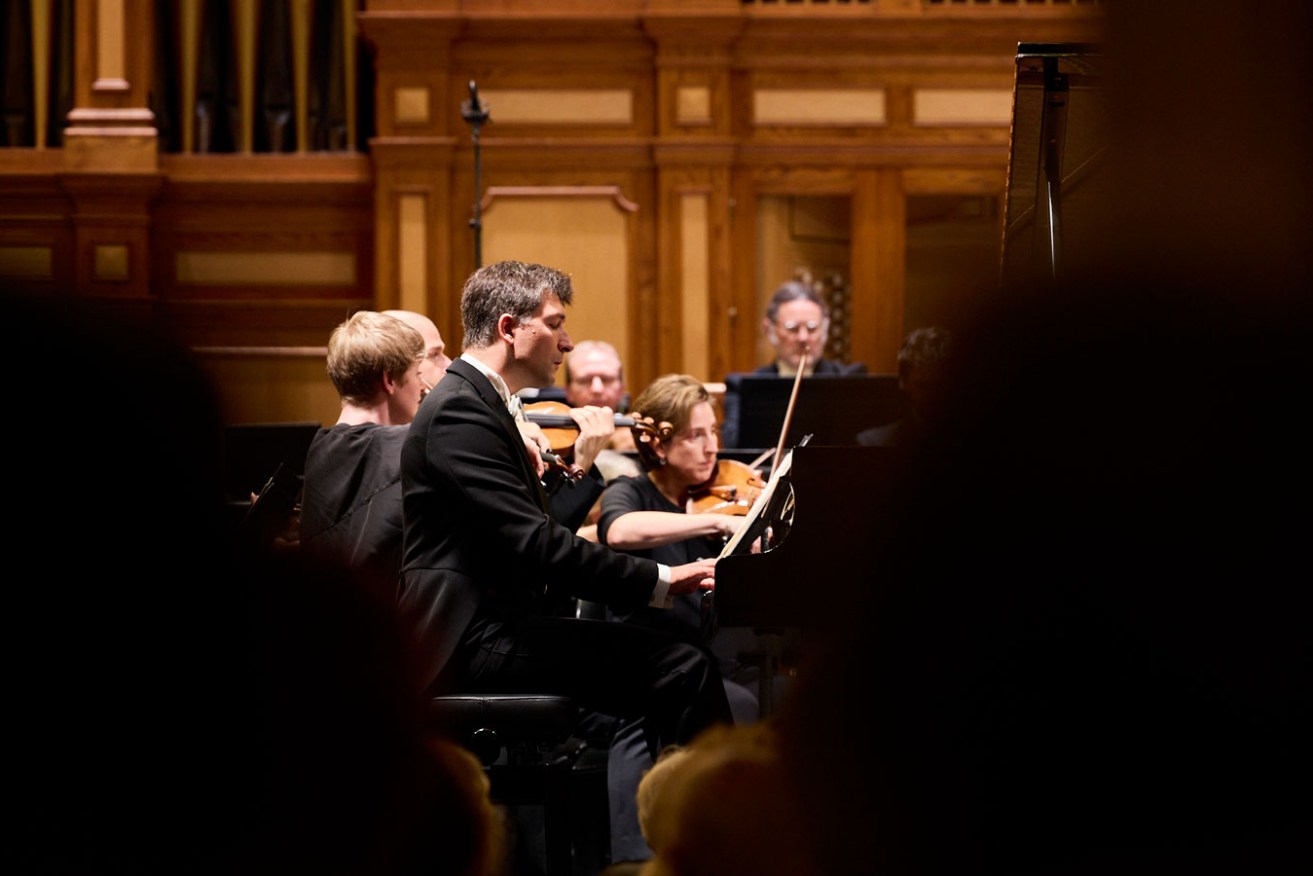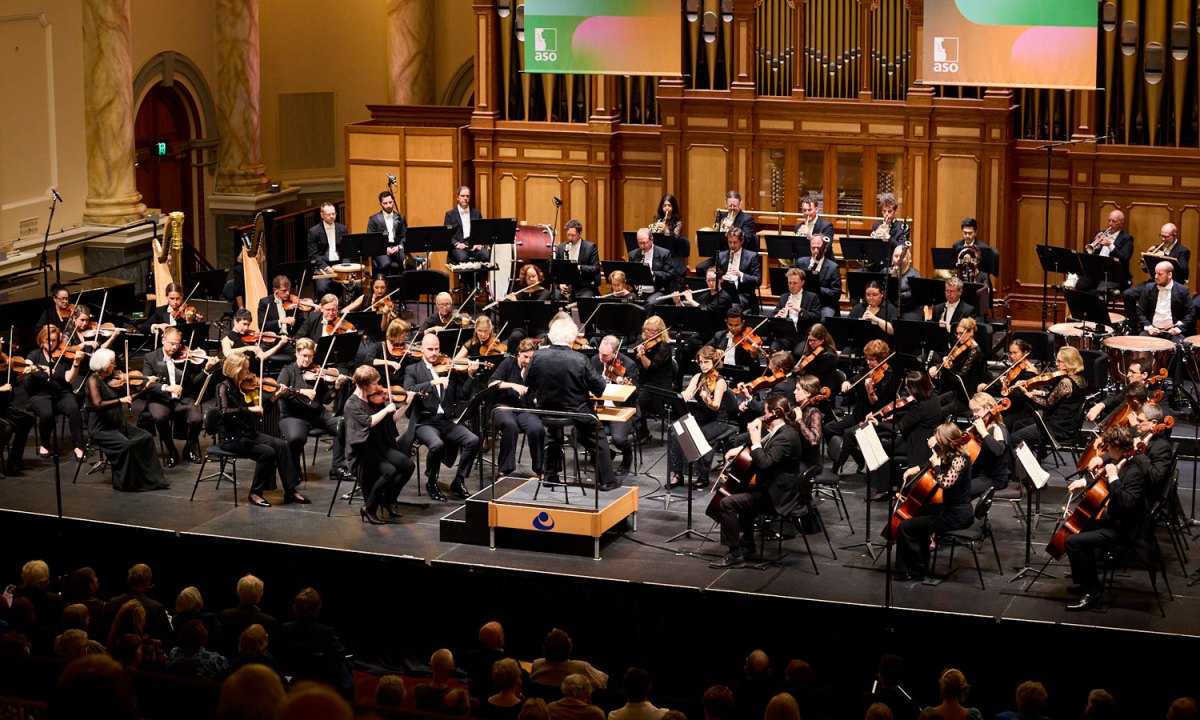Music review: ASO’s Panorama
Only when the music palpably means everything in the world to the musician might it truly move an audience. This was clearly the case when Adelaide’s own Russian star pianist Konstantin Shamray and ASO veteran conductor Nicholas Braithwaite took to the stage for Panorama.


Pianist Konstantin Shamray performs with the Adelaide Symphony Orchestra for its Panorama concert. Photo: Claudio Raschella
Each of these esteemed musicians has his own, and by now well-known, leanings: Shamray to heavyweight Romantic repertoire of the ultra-virtuosic variety, and Braithwaite to opera and the English pastoral school of composers. That’s to over-simplify matters; however, it might serve to highlight how remarkable it is when two very different and apparently unmatched artists can come together and totally exhilarate an audience.
Even before this ASO Symphony Series concert started, the air was abuzz on stage, and that’s always a good sign. Maybe it was because the orchestra had its own little surprise up its sleeve.
You can be forgiven for not having heard of Louise Farrenc. Wikipedia does not have her in its 60-strong list of 19th-century pianists, and shamefully she is even ignored it its “subcategory” of 19th-century women pianists. Yet as a concert pianist in her day, she was highly admired and was made the first female professor at the Paris Conservatoire. As a composer, she was praised by Berlioz and Schumann.
Salutations to the ASO for programming her Overture No.2 in E flat, Op.24 (1834), for the first time, and for playing it with great spirit. It’s a gutsy, vivacious piece. As Russell Torrance noted in his pre-concert remarks, the drama-charged opening of this overture sounds rather like Mozart’s Don Giovanni Overture. Without disclosing any discernible French traits, Farrenc’s overture looks more to the Germans in its lustrous, layered orchestral style.
Original and thoroughly modern for its time, it follows nobody else’s lead but her own. It is to be hoped the ASO’s exploration of female composers yields further such discoveries.
Except for the Farrenc, Panorama was hardly the most adventurous of programs, yet it happened to be remarkable for the performances that followed. After Shamray’s successes with other big-name piano concertos, we can be glad he agreed to the ASO’s request to play Grieg’s Piano Concerto in A minor, Op.16, the Norwegian composer’s much-admired contribution to the genre.
From the craggy octaves of its first entry, his vision of this work was one of considerable forethought and artistic truthfulness. Being of Russian training, Shamray’s pianism is characteristically big, intense and serious, but he held back from applying outright power to this concerto, instead bringing out its colouristic contrasts and discovering its essential melodic nature.
When the opening Lisztian bravado recedes, the soloist needs to instantly change gear to become, as it were, a salon pianist whose job is merely to tickle the ear with curls of melody. Shamray did this exquisitely. As we know from his playing in Tchaikovsky, Rachmaninov and Prokofiev concertos, he has technique to burn, but to hear him approach moments like this so simply and lovingly was a pure delight.
What is so admirable about Shamray is that he places his virtuosic technique where it is needed rather than sprinkling it everywhere. So when he pulled the tempo right back for the cadenza and gradually accelerated towards an exhilarating climax, it made for total artistry.
There were moments when he was a fraction ahead of the orchestra – otherwise their partnership was ideal. This was a balanced and above all beautiful reading, as fine as one might ever have wished.

The ASO, under conductor Nicholas Braithwaite. Photo: Claudio Rashcella
Hopes for great things in Elgar’s Symphony No.1 in A flat, Op.55, under Nicholas Braithwaite’s conducting, proved rightfully placed. This was a marvellous performance, too, conveying the full noble breadth of this magnificent work.
Braithwaite has a conducting style that we don’t see often nowadays, but it’s one that works uniquely well for Elgar. Using gently flowing gestures of hand, he guides the orchestra in an unfussed way, not imposing a metrical beat so much as allowing the music room to breathe and gather weight along the course of its accumulating momentum.
Memorably, Elgar delays full treatment of this symphony’s proud main theme until the very end, but when that final statement comes in all its emblazoning glory, it can send tingles down the spine. With first-class commitment and playing from the orchestra, it certainly did on this occasion. Through all the work’s knotty, muscular textures to its final triumphal cry of brass, the musicians’ sense of unity of purpose was unswerving.
The ASO’s new concertmaster, Kate Suthers, can take much credit in having prepared the orchestra so well for this performance, and Celia Craig deserves special mention for stepping in so ably at the last minute (quite literally, following a slightly extended interval) to take the Cor Anglais part.
However, the lion’s share of praise, of course, goes to Braithwaite. Recently crowned Conductor Laureate of the ASO, he is just bliss with Elgar and these later romantics, whose music he makes resonate just as strongly today as it did more than a century ago.
The Adelaide Symphony Orchestra presented Panorama at the Town Hall. Its next Symphony Series concert will be Wild, featuring conductor Benjamin Northey and soloist Emily Sun, on April 21 and 22.




